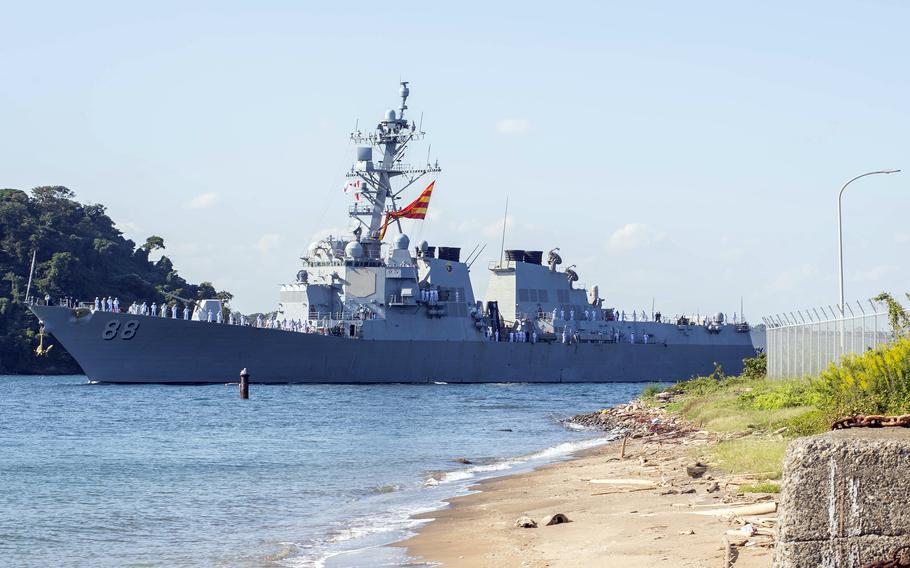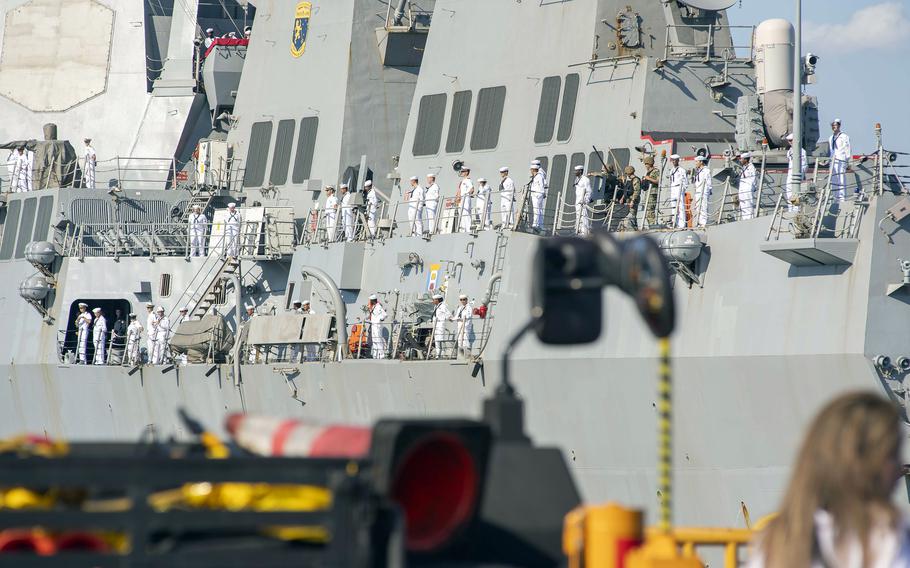
USS Preble sailors man the rails as the guided-missile destroyer pulls into Yokosuka Naval Base, Japan, Oct. 12, 2024. (Quinton Lee/U.S. Navy)
YOKOSUKA NAVAL BASE, Japan — A guided-missile destroyer equipped with a high-energy laser joined the U.S. 7th Fleet over the weekend to begin testing the weapon’s effectiveness at sea.
Sailors in dress whites manned the rails Saturday as the USS Preble pulled into Tokyo Bay and moored at Yokosuka, where it became the 10th destroyer assigned to Destroyer Squadron 15.
The Preble’s arrival from Naval Base San Diego brings a new capability to the fleet. It is the only U.S. warship equipped with the High-Energy Laser with Integrated Optical-dazzler and Surveillance, or HELIOS, system.
The 60-kilowatt directed energy weapons system is designed to counter small watercraft or drones and collect long-range intelligence, according to manufacturer Lockheed Martin’s website.
HELIOS can “dazzle,” or blind or impair sensors aboard surveillance drones, or punch a hole through drones, low-flying aircraft and, in some cases, missiles, according to Lockheed Martin executive Joe Ottaviano, quoted by National Defense magazine in February 2021.
HELIOS is currently in the at-sea testing phase, Task Force 70 spokesman Lt. Cmdr. Seth Koenig told Stars and Stripes by phone Tuesday. The typical overseas deployment for a destroyer is about a decade, but there is currently no defined time associated with the Preble’s assignment to Yokosuka, he said.

USS Preble sailors man the rails as the guided-missile destroyer pulls into Yokosuka Naval Base, Japan, Oct. 12, 2024. (Quinton Lee/U.S. Navy)
Lockheed Martin, starting work under a $150 million contract in 2018, installed HELIOS aboard Preble in 2022, according to media reports cited by the Congressional Research Service for an Aug. 6 update on Navy-directed energy weapons. HELIOS performed well in land-based tests in fall 2021 at the Navy’s Surface Combat Systems Center on Wallops Island, Va., according to the report.
The Navy is actively pursuing systems like HELIOS to improve warships’ survivability against large numbers of drones and anti-ship missiles such as those employed by China, the report said.
HELIOS is primarily intended to defend the Preble itself, but it’s also shown some ability to defend other ships in its vicinity, according to the Congressional Research Service report.
Unlike missiles and close-in weapons systems, whose shipboard magazines are finite and may require a trip of thousands of miles to replenish, lasers run on the ship’s power supply and are theoretically inexhaustible.
Other potential advantages are fast engagement times, an ability to counter radically maneuvering missiles and conduct precision engagements, and an ability to use lasers for graduated responses ranging from detecting and monitoring targets to causing disabling damage, according to the research service report.
However, solid-state lasers like HELIOS have limited range — a mile to several miles — and are best as short-range defensive weapons, according to the report.
The HELIOS system works in sync with the Preble’s Flight IIA Aegis Combat System — the Navy’s command-and-control suite aboard guided-missile destroyers, according to Lockheed Martin.
That may prove to be a downside, however, if the Navy wants to install the system aboard Flight III variants of Arleigh Burke-class destroyers such as the USS Jack H. Lucas launched in June 2021. The system uses almost the same amount of power as the Flight III variant’s AN/SPY-6 Air and Missile Defense Radar.
To install HELIOS on a newer variant, the Navy would have to remove other equipment or consider “very aggressive power management,” according to the research service report, which cited a March 2019 article from Defense Daily.
Other potential drawbacks include line-of-sight limitations, poor performance in certain weather conditions, ineffectiveness against hardened targets or countermeasures and risk of damage to aircraft, satellites or human eyesight, the Congressional Research Service found.
The Preble replaces the guided-missile destroyer USS Benfold, which is due to relocate soon to Everett, Wash., but was still at Yokosuka as of Tuesday.